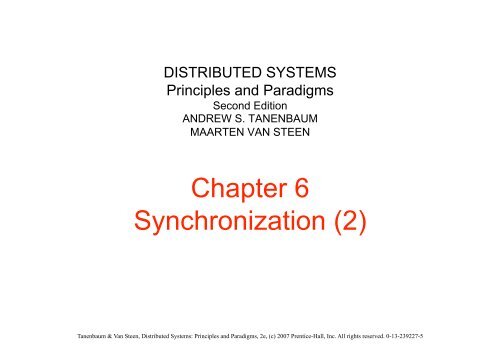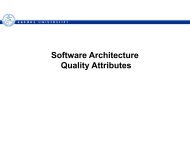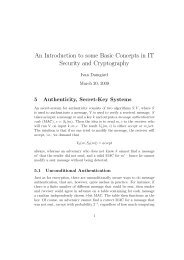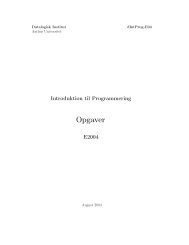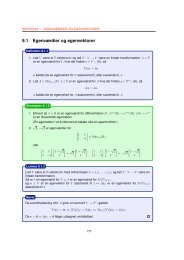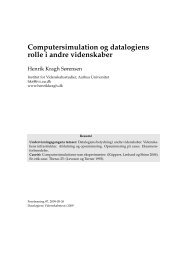4. Synchronization (2).pdf
4. Synchronization (2).pdf
4. Synchronization (2).pdf
You also want an ePaper? Increase the reach of your titles
YUMPU automatically turns print PDFs into web optimized ePapers that Google loves.
DISTRIBUTED SYSTEMS<br />
Principles and Paradigms<br />
Second Edition<br />
ANDREW S. TANENBAUM<br />
MAARTEN VAN STEEN<br />
Chapter 6<br />
<strong>Synchronization</strong> (2)<br />
Tanenbaum & Van Steen, Distributed Systems: Principles and Paradigms, 2e, (c) 2007 Prentice-Hall, Inc. All rights reserved. 0-13-239227-5
Plan<br />
• Clock synchronization in distributed<br />
systems<br />
– Physical clocks<br />
– Logical clocks<br />
• Ordered multicasting<br />
– JGroups<br />
• Mutual exclusion<br />
• Election<br />
Tanenbaum & Van Steen, Distributed Systems: Principles and Paradigms, 2e, (c) 2007 Prentice-Hall, Inc. All rights reserved. 0-13-239227-5
JGroups<br />
• Java toolkit for reliable group communication<br />
– Join group<br />
– Send to all or single group members<br />
– Receive messages from group<br />
Unreliable Reliable<br />
Unicast UDP TCP<br />
Multicast IP Multicast JGroups<br />
Tanenbaum & Van Steen, Distributed Systems: Principles and Paradigms, 2e, (c) 2007 Prentice-Hall, Inc. All rights reserved. 0-13-239227-5
JGroups<br />
• Channels<br />
– Similar to (BSD) sockets – pullbased<br />
– Connected to a protocol stack<br />
• Protocol stack<br />
– Bidirectional list of protocol<br />
layers<br />
• Building blocks for higher-level<br />
functionality<br />
– E.g., PullPushAdapter,<br />
RpcDispatcher<br />
• Used, e.g., for replication and<br />
load balancing in a number of<br />
application servers<br />
– E.g., JBoss, Tomcat<br />
Tanenbaum & Van Steen, Distributed Systems: Principles and Paradigms, 2e, (c) 2007 Prentice-Hall, Inc. All rights reserved. 0-13-239227-5
Jgroups Programming Basics<br />
• Processes decide on a<br />
group name<br />
• Each process<br />
1. Creates a channel<br />
2. Connects to that channel<br />
• Using the group name<br />
• This means starting the protocol<br />
stack<br />
3. Sends messages to and<br />
receives messages from the<br />
channel<br />
• The concrete multicast depends<br />
on the protocol stack<br />
<strong>4.</strong> Eventually disconnects from<br />
the channel<br />
• This means stopping the<br />
associated protocol stack<br />
Tanenbaum & Van Steen, Distributed Systems: Principles and Paradigms, 2e, (c) 2007 Prentice-Hall, Inc. All rights reserved. 0-13-239227-5
JGroups<br />
• JGroup’s protocol stack has a number of<br />
ordering possibilities<br />
– None<br />
– org.jgroups.protocols.CAUSAL<br />
– org.jgroups.protocols.TOTAL<br />
Tanenbaum & Van Steen, Distributed Systems: Principles and Paradigms, 2e, (c) 2007 Prentice-Hall, Inc. All rights reserved. 0-13-239227-5
JGroups: Alphabet Example<br />
• Stable process group<br />
• Send parts of alphabet in sequence<br />
– Initiator<br />
• Select address of random member in group<br />
• Multicasts {”A”, }<br />
– Receivers print ”A”, stores ”A”<br />
– Receiver with address <br />
• Select address of random member in group<br />
• Multicasts {”B”, }<br />
– And so on...<br />
• Which ordering do we want<br />
Tanenbaum & Van Steen, Distributed Systems: Principles and Paradigms, 2e, (c) 2007 Prentice-Hall, Inc. All rights reserved. 0-13-239227-5
JGroups: Alphabet Example<br />
Tanenbaum & Van Steen, Distributed Systems: Principles and Paradigms, 2e, (c) 2007 Prentice-Hall, Inc. All rights reserved. 0-13-239227-5
JGroups: Alphabet Example<br />
Create channel<br />
Connect to group<br />
Listen to messages<br />
Listen to group changes<br />
Send an initial message<br />
A message contains a source (null), a destination (null), and<br />
A Serializable object (an array with two values)<br />
Listen to changes in the view<br />
Tanenbaum & Van Steen, Distributed Systems: Principles and Paradigms, 2e, (c) 2007 Prentice-Hall, Inc. All rights reserved. 0-13-239227-5
Tanenbaum & Van Steen, Distributed Systems: Principles and Paradigms, 2e, (c) 2007 Prentice-Hall, Inc. All rights reserved. 0-13-239227-5
Receive a massage<br />
Unpack letter and handler<br />
Close connection and terminate<br />
Find a new handler<br />
Send off next letter<br />
Tanenbaum & Van Steen, Distributed Systems: Principles and Paradigms, 2e, (c) 2007 Prentice-Hall, Inc. All rights reserved. 0-13-239227-5
JGroups: Stack setup<br />
Use UDP communication<br />
Ping via mcast<br />
Discover<br />
subgroups<br />
To make the example more interesting…<br />
Heartbeat-based failure detection<br />
Check that FD is correct<br />
And finally causal multicast…<br />
Tanenbaum & Van Steen, Distributed Systems: Principles and Paradigms, 2e, (c) 2007 Prentice-Hall, Inc. All rights reserved. 0-13-239227-5
Plan<br />
• Clock synchronization in distributed<br />
systems<br />
– Physical clocks<br />
– Logical clocks<br />
• Ordered multicasting<br />
– JGroups<br />
• Mutual exclusion<br />
• Election<br />
Tanenbaum & Van Steen, Distributed Systems: Principles and Paradigms, 2e, (c) 2007 Prentice-Hall, Inc. All rights reserved. 0-13-239227-5
Mutual Exclusion<br />
• We often want to ensure<br />
that only one process<br />
accesses a critical region<br />
• Requirements: ensure<br />
– Mutually exclusive access<br />
– Deadlock freedom<br />
– Starvation freedom<br />
– Fairness<br />
• Types of algorithms<br />
– Permission-based<br />
– Token-based<br />
Tanenbaum & Van Steen, Distributed Systems: Principles and Paradigms, 2e, (c) 2007 Prentice-Hall, Inc. All rights reserved. 0-13-239227-5
Mutual Exclusion:<br />
A Centralized Algorithm<br />
• Simulate how mutual exclusion is done in a<br />
one-processor system<br />
– Let one process act as a coordinator<br />
– Send request to coordinator to ask for permission<br />
Tanenbaum & Van Steen, Distributed Systems: Principles and Paradigms, 2e, (c) 2007 Prentice-Hall, Inc. All rights reserved. 0-13-239227-5
Mutual Exclusion:<br />
A Centralized Algorithm<br />
• Mutually exclusive access<br />
– Coordinator only lets one process in<br />
• Deadlock freedom<br />
– If no process is in critical region, any other<br />
that wants to can be granted<br />
• Starvation freedom<br />
• Fairness<br />
– Access granted in order of receipt at<br />
coordinator<br />
• Only 3 messages per ressource use<br />
– But coordinator is single point of failure and<br />
potential bottleneck<br />
Tanenbaum & Van Steen, Distributed Systems: Principles and Paradigms, 2e, (c) 2007 Prentice-Hall, Inc. All rights reserved. 0-13-239227-5
Mutual Exclusion:<br />
A Decentralized Algorithm<br />
• Sigma: algorithm based on DHTs<br />
– Logically replicate ressource to n coordinators<br />
• Name ith replica ”r_name-i” and let node with id<br />
lookup(r_name-i) be responsible for it<br />
– To enter into criticial region<br />
• Get grant from m > n/2 coordinators<br />
• If cannot get enough grants, give up and retry later<br />
– Problem: failure/recovery of coordinator<br />
• May handle up to f failures where<br />
–<br />
• Probability of violating mutual exclusion is small<br />
Tanenbaum & Van Steen, Distributed Systems: Principles and Paradigms, 2e, (c) 2007 Prentice-Hall, Inc. All rights reserved. 0-13-239227-5
Mutual Exclusion:<br />
A Decentralized Algorithm<br />
• Mutual exclusion<br />
– Average lifetime of node is 10000 seconds<br />
Tanenbaum & Van Steen, Distributed Systems: Principles and Paradigms, 2e, (c) 2007 Prentice-Hall, Inc. All rights reserved. 0-13-239227-5
Mutual Exclusion:<br />
A Distributed Algorithm<br />
• Totally ordered multicast of requests for resources from requester to<br />
receivers<br />
1. Receiver did not send request: Send OK back<br />
2. Receiver sent request, is accessing resource: Wait and queue request<br />
3. Receiver sent request, is not accessing resource<br />
• Receiver has higher timestamp on its request: Send OK back<br />
• Receiver has lower timestamp on its: Wait and queue request<br />
• When requester has OK from all processes it accesses resource<br />
– When done, send OK to all processes in queue<br />
Tanenbaum & Van Steen, Distributed Systems: Principles and Paradigms, 2e, (c) 2007 Prentice-Hall, Inc. All rights reserved. 0-13-239227-5
Mutual Exclusion:<br />
A Distributed Algorithm<br />
• Guarantees<br />
– Mutual exclusion<br />
• Need OK from all processes<br />
– Deadlock freedom<br />
– Starvation freedom<br />
– Fairness<br />
• Timestamp used to decide<br />
• But<br />
– n-points-of-failure (instead of 1)<br />
• Could try to detect whether resource<br />
has failed<br />
– n bottlenecks (instead of 1)<br />
• Could try to just get OK from majority<br />
Tanenbaum & Van Steen, Distributed Systems: Principles and Paradigms, 2e, (c) 2007 Prentice-Hall, Inc. All rights reserved. 0-13-239227-5
Mutual Exclusion:<br />
A Token Ring Algorithm<br />
• Assume processes can be connected in a (logical) ring<br />
– Token circulates on the ring<br />
– Take the token if need to access critical region<br />
– If token not needed, send it to next neighbor<br />
Tanenbaum & Van Steen, Distributed Systems: Principles and Paradigms, 2e, (c) 2007 Prentice-Hall, Inc. All rights reserved. 0-13-239227-5
Mutual Exclusion:<br />
A Token Ring Algorithm<br />
• Guarantees<br />
– Only one token at one process in a given time<br />
• Mutual exclusion, deadlock freedom, starvation freedom,<br />
fairness<br />
• But<br />
– What if token is lost<br />
– Process crashes<br />
Tanenbaum & Van Steen, Distributed Systems: Principles and Paradigms, 2e, (c) 2007 Prentice-Hall, Inc. All rights reserved. 0-13-239227-5
A Comparison of the Four Algorithms<br />
• Figure 6-17. A comparison of three mutual<br />
exclusion algorithms.<br />
Tanenbaum & Van Steen, Distributed Systems: Principles and Paradigms, 2e, (c) 2007 Prentice-Hall, Inc. All rights reserved. 0-13-239227-5
Election<br />
• There is often a need for selecting a process<br />
with some special role<br />
– E.g., choose coordinator in a centralized protocol<br />
• If processes have unique id<br />
– Try to find process with highest id, make this leader<br />
– Algorithms differ in how they locate process with<br />
highest id<br />
• If processes do not have unique id (or similar)<br />
– Then there is no way to select any of them to be<br />
special<br />
– Well…<br />
Tanenbaum & Van Steen, Distributed Systems: Principles and Paradigms, 2e, (c) 2007 Prentice-Hall, Inc. All rights reserved. 0-13-239227-5
Population Protocol<br />
• All agents start in same state<br />
– Eventually one agent is leader<br />
Tanenbaum & Van Steen, Distributed Systems: Principles and Paradigms, 2e, (c) 2007 Prentice-Hall, Inc. All rights reserved. 0-13-239227-5
JGroups and Election<br />
• Just use view and choose the first process<br />
in the view to be elected<br />
Tanenbaum & Van Steen, Distributed Systems: Principles and Paradigms, 2e, (c) 2007 Prentice-Hall, Inc. All rights reserved. 0-13-239227-5
The Bully Algorithm<br />
• Assume that every process knows the ids of<br />
every other process<br />
– Static group, but members may have failed<br />
• P notices that there is no coordinator – P wants<br />
to hold an election<br />
– P sends an ELECTION message to all processes with<br />
higher numbers<br />
– If no one responds, P wins the election and becomes<br />
coordinator<br />
– If one of the higher-ups answers, it takes over – P’s<br />
job is done<br />
Tanenbaum & Van Steen, Distributed Systems: Principles and Paradigms, 2e, (c) 2007 Prentice-Hall, Inc. All rights reserved. 0-13-239227-5
The Bully Algorithm (1)<br />
• Figure 6-20. The bully election algorithm. (a) Process 4 holds<br />
an election. (b) Processes 5 and 6 respond, telling 4 to stop. (c)<br />
Now 5 and 6 each hold an election.<br />
Tanenbaum & Van Steen, Distributed Systems: Principles and Paradigms, 2e, (c) 2007 Prentice-Hall, Inc. All rights reserved. 0-13-239227-5
The Bully Algorithm (2)<br />
• Figure 6-20. The bully election algorithm. (d) Process 6<br />
tells 5 to stop. (e) Process 6 wins and tells everyone.<br />
Tanenbaum & Van Steen, Distributed Systems: Principles and Paradigms, 2e, (c) 2007 Prentice-Hall, Inc. All rights reserved. 0-13-239227-5
A Ring Algorithm<br />
• Build view of processes by circulating message<br />
– Two steps: ELECTION and COORDINATOR<br />
– ELECTION message constructs view of alive processes during<br />
circulation<br />
– Choose process with highest id from view as coordinator<br />
Tanenbaum & Van Steen, Distributed Systems: Principles and Paradigms, 2e, (c) 2007 Prentice-Hall, Inc. All rights reserved. 0-13-239227-5
Elections in Wireless Environments<br />
• Limited range of wireless<br />
• May want to elect node with particular<br />
properties<br />
– High battery-level<br />
– Near the “middle” of the network<br />
– …<br />
• Assume stability and reliability initially<br />
Tanenbaum & Van Steen, Distributed Systems: Principles and Paradigms, 2e, (c) 2007 Prentice-Hall, Inc. All rights reserved. 0-13-239227-5
Elections in Wireless Environments (1)<br />
• Figure 6-22. Election algorithm in a wireless network, with node<br />
a as the source. (a) Initial network. (b)–(e) The build-tree phase<br />
Tanenbaum & Van Steen, Distributed Systems: Principles and Paradigms, 2e, (c) 2007 Prentice-Hall, Inc. All rights reserved. 0-13-239227-5
Elections in Wireless Environments (2)<br />
• Figure 6-22. Election algorithm in a wireless network,<br />
with node a as the source. (a) Initial network. (b)–(e) The<br />
build-tree phase<br />
Tanenbaum & Van Steen, Distributed Systems: Principles and Paradigms, 2e, (c) 2007 Prentice-Hall, Inc. All rights reserved. 0-13-239227-5
Elections in Wireless Environments (3)<br />
• Figure 6-22. (e) The build-tree phase.<br />
(f) Reporting of best node to source.<br />
Tanenbaum & Van Steen, Distributed Systems: Principles and Paradigms, 2e, (c) 2007 Prentice-Hall, Inc. All rights reserved. 0-13-239227-5
Elections in Wireless Environments (4)<br />
• Handling split and merge<br />
– Use probe/reply messages to see if children in<br />
spanning tree are gone<br />
• Handling node crashes and recovery<br />
– Crash is a special case of split<br />
– Recovery is treated as a special case of<br />
merge<br />
Tanenbaum & Van Steen, Distributed Systems: Principles and Paradigms, 2e, (c) 2007 Prentice-Hall, Inc. All rights reserved. 0-13-239227-5
Elections in Large-Scale Systems (1)<br />
• Requirements for superpeer selection:<br />
1. Normal nodes should have low-latency<br />
access to superpeers.<br />
2. Superpeers should be evenly distributed<br />
across the overlay network.<br />
3. There should be a predefined portion of<br />
superpeers relative to the total number of<br />
nodes in the overlay network.<br />
<strong>4.</strong> Each superpeer should not need to serve<br />
more than a fixed number of normal nodes.<br />
Tanenbaum & Van Steen, Distributed Systems: Principles and Paradigms, 2e, (c) 2007 Prentice-Hall, Inc. All rights reserved. 0-13-239227-5
Elections in Large-Scale Systems (2)<br />
• Assume we want L leaders in m-bit Chord<br />
DHT<br />
– Reserve don’t care bits<br />
– p does lookup(p && 11…11000) to detect if it<br />
is the leader<br />
k<br />
• Each super-peer is then responsible for<br />
with high probability<br />
Tanenbaum & Van Steen, Distributed Systems: Principles and Paradigms, 2e, (c) 2007 Prentice-Hall, Inc. All rights reserved. 0-13-239227-5
Summary<br />
• Mutual exclusion<br />
– Centralized<br />
– Decentralized<br />
– Distributed<br />
– Token-based<br />
• Election<br />
– Bully<br />
– Ring<br />
– Decentral and large-scale<br />
Tanenbaum & Van Steen, Distributed Systems: Principles and Paradigms, 2e, (c) 2007 Prentice-Hall, Inc. All rights reserved. 0-13-239227-5


